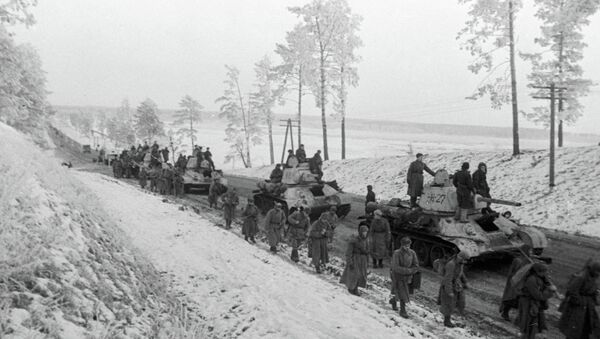MOSCOW, October 28 (RIA Novosti) – Ukraine celebrates the day of liberation from Nazi occupation in WWII annually, on October 28.
Combat operations in Ukraine lasted for 40 months during World War II: from the beginning of the Great Patriotic War (a term used in Russia and other ex-Soviet states to describe the conflict between the Soviet Union and Nazi Germany) on June 22, 1941, until late October, 1944.
By the middle of July 1941, the Nazi armies had seized western Ukraine. In August-September, Ukrainian lands on the left bank of the Dnieper wound up in German hands. On October 24, Kharkiv surrendered. By November 4 the Soviet army had retreated to the line connecting the towns of Balakleya – Artyomovsk – Pugachov — Khopry. The greater part of Donbas (Ukraine's southeastern regions) was occupied.
The first towns and villages liberated in December 1942 were in eastern Donbas. Battles for the liberation of Ukraine continued from January 1943 until the autumn of 1944. During this period, up to a half of the Soviet troops were fighting on Ukrainian territory.
The guerrilla movement became an important military factor behind German lines starting in the winter of 1942-1943. Guerrillas inflicted significant damage on the German army by killing troops, blowing up storage facilities and trains, and disrupting the communications system. The largest guerrilla operations were raids by Mikhail Naumov's unit through the Sumy, Poltava, Odessa, Vinnytsia, Kiev and Zhytomyr regions between February and March of 1943, and by Sidor Kovpak's unit through the Rivne, Zhytomyr and Kiev regions in February-May 1943.
By late January 1943 the armies of the Southwestern and Southern fronts had launched an assault on Donbas. The troops of the Southwestern Front defeated the 1st Panzer Army and liberated northern Donbas. Kharkiv was recaptured on February 16. A month later the Germans regained Kharkiv, which was finally liberated on August 23, 1943.
By September 22 the units of the Southwestern Front pushed the Germans behind the Dnieper and advanced to the threshold of Dnipropetrovsk and Zaporizhia, thereby liberating Donbas. On September 8 the Soviet Army liberated Stalino (now Donetsk).
On October 11 the Voronezh Front (renamed into 1st Ukrainian Front on October 20) began the Kiev operation. After two unsuccessful attempts to capture the Ukrainian capital by an assault from the south (from the Bukrin bridgehead), a decision was made to launch the main attack from the north (from the Lyutezh bridgehead). On November 1 the 27th and 40th armies advanced from the Bukrin bridgehead in order to distract the enemy, while on November 3 the main attack force of the 1st Ukrainian Front broke through the enemy defenses. Kiev was liberated on November 6.
Owing to the 1943-44 winter campaign, German troops were completely pushed away from the Dnieper.
In early March 1944 the units of the three Ukrainian fronts embarked on a large-scale assault operation stretching along 1,100 kilometers from Lutsk to the mouth of the Dnieper.
The Soviet army took Kherson on March 13, Nikolayev on March 28, and Odessa on April 10, and on April 14 advanced to the downstream Dniester and captured several bases on its right bank.
The joint activities of the three Ukrainian fronts resulted in the liberation of Ukraine on the right bank of the Dnieper in the course of seven operations.
During the Lviv-Sandomierz assault operation from July 13 to August 29, 1944, Soviet troops crushed the strategic forces of the enemy – the Northern Ukraine army group – and liberated the western regions of Ukraine – the cities of Lviv and Rava Ruska.
The East Carpathian operation (September 8 through October 28, 1944) completed the liberation of Ukraine. On October 26 the units of the 4th Ukrainian Front liberated Mukachevo, on October 27 – Uzhgorod and on October 28 – Chop.
On October 28 the Soviet forces reached the modern borders of Ukraine.
Historians estimate that about three million Soviet troops died in military operations in Ukraine, and over two million Ukrainians were taken to Germany for forced labor during the occupation. Over 700 cities and towns and 28,000 villages were partially or completely destroyed, about 10 million people were left homeless and over 16,000 industrial enterprises were ravaged.
Ukraine marks the day of liberation from German invaders on October 28. The national celebration was introduced by President Viktor Yushchenko by his decree of October 21, 2009.
The day was not previously marked at the national level. However, war veterans participated in festivities held in Ukrainian regions on October 28.


